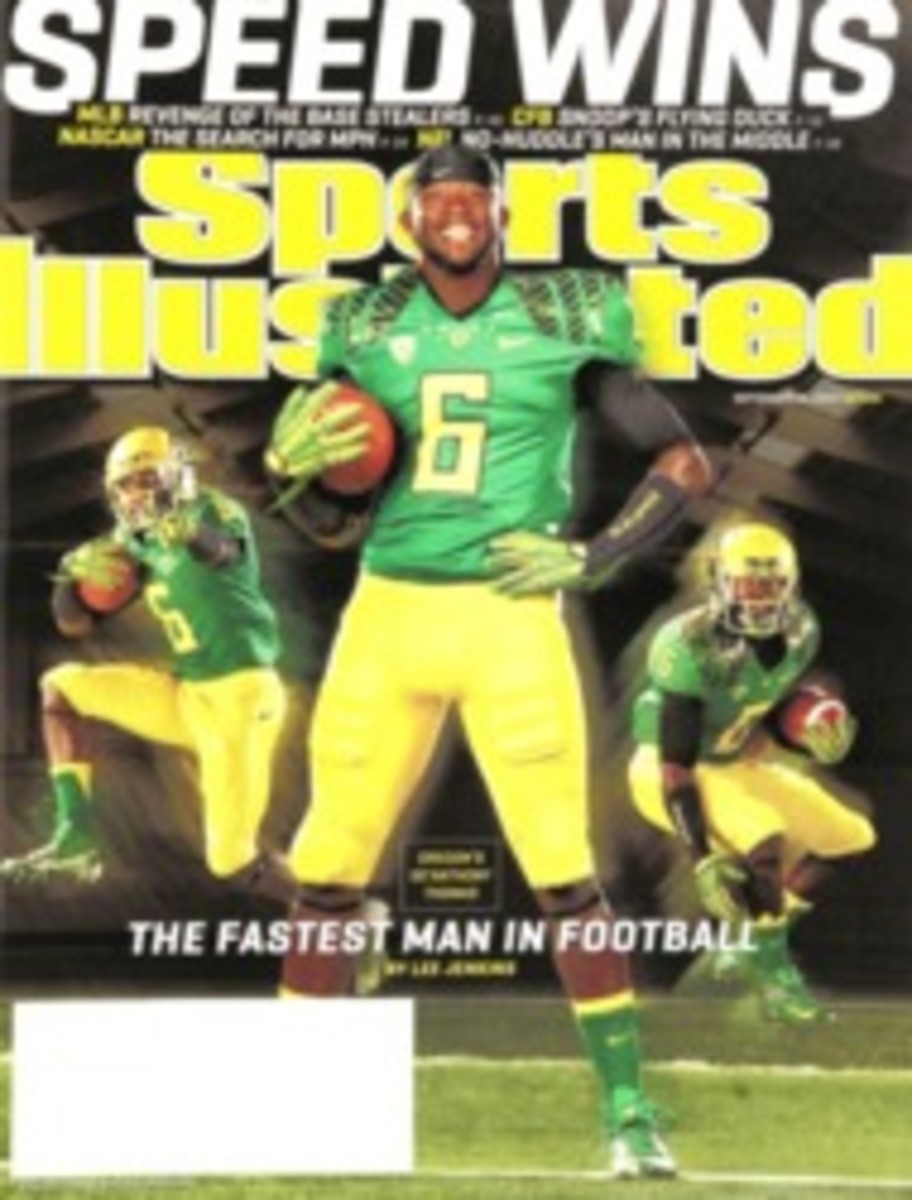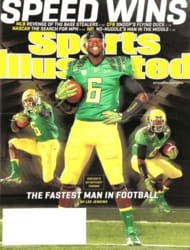
No Time To Talk
THE HUDDLE IS FADING FAST AS MORE TEAMS PUSH A BREAKNECK PACE TO KEEP DEFENSES OFF-BALANCE
The essence of the new NFL was distilled in a cartoon on Sunday afternoon. Late in the third quarter of the Eagles' 24--23 come-from-behind victory over the Ravens at Lincoln Financial Field, Philly wideout DeSean Jackson zipped down the right sideline and hauled in a beautifully thrown 49-yard pass from Michael Vick.
As Jackson celebrated with an emphatic first down gesture, the scoreboard played a video of what appeared to be the Road Runner leaving Wile E. Coyote in his dust. But it was Jackson's image that filled the screen, along with the caption RECEIVERUS FASTUS GAME-BREAKERUS.
The joke delighted the home crowd of 69,144, and it served as a reminder that speed is the NFL's ultimate game changer—in more ways than one: Had the Eagles not called a timeout after the play, fans might not have seen the clip. Both teams ran no-huddle offenses for much of the game, leaving little time for anyone to catch his breath, much less enjoy a video.
More than ever, the NFL tempo is breakneck, making defenses scramble to keep up. To varying degrees the no-huddle was used by 15 teams in Week 1. By Sunday that number had risen to 20. "You typically have to score a lot of points to win," explains Eagles offensive coordinator Marty Mornhinweg, "and a lot of offenses are calling three or maybe even four plays, [then picking one] depending on what they [see] from defenses."
The no-huddle can differ from the two-minute drill, which is used to conserve time and move the ball quickly late in a half or when trailing big. But it's not a reinvention of the wheel—Bengals coach Sam Wyche rolled with the no-huddle in the mid-1980s, and Bills quarterback Jim Kelly pimped out its rims in the '90s.
Its advantages are numerous. The ball can be snapped quickly to exploit defenses that aren't set. Quarterbacks can line up early and bark false cadences, forcing opponents to betray blitzes and coverages. By pushing the pedal, offenses limit defensive substitutions and exploit mismatches. And by heading straight to the line rather than burning time in the huddle, quarterbacks can read defenses while a coach in the booth shares his bird's-eye view in the QB's helmet earpiece. (The connection turns off with 15 seconds left on the 40-second play clock.)
The cumulative effect? "A defense starts to break," Eagles center Jason Kelce says. "They lose their legs and the integrity of their gaps. They're more often out of position."
Baltimore used the no-huddle almost exclusively in its season-opening 44--13 win over Cincinnati. Joe Flacco played a little more than three quarters and completed 21 of 29 passes for 299 yards, two TDs and a 128.4 rating.
But the scheme requires clear and audible signals from the quarterback, and that's where it can run into trouble. In Philadelphia, where the crowd was so loud that Ravens right guard Marshal Yanda often had to look over his shoulder and tap the center's butt when Flacco was ready for the snap, Baltimore's no-huddle lost its effectiveness. Flacco hit on just 22 of 44 passes for 232 yards and a 66.8 rating. "No-huddle does much better at home stadiums than away," Kelce says.
Vick benefited from that home advantage. In Week 1, operating primarily out of a regular set, he led the Eagles to a 17--16 last-minute win in Cleveland. But he took a beating: two sacks, 11 knockdowns. On Sunday, using the no-huddle against the league's top-ranked defense, Vick suffered just five combined sacks and hits. When he scored the game-winning TD on a one-yard plunge off left tackle with 1:57 to play, his legs were fresh.
"It's great to go no-huddle," Vick says. "It just pushes the pace. Sometimes they couldn't even get lined up."
Dashing Dudes
RAW SPEED—it's why in August the Patriots signed Jeff Demps, who won Olympic silver in London in the 4 √ó 100 relay, and why three teams tried out 100-meter record holder Justin Gatlin after he was banned from track for PED use—even though he hadn't played since the 10th grade. Gatlin never made a pro roster, and New England stashed Demps on its IR, but scores of other All-World speedsters have turned on their afterburners in the NFL, some with more success (Jim Thorpe, Marion Motley and O.J. Simpson) than others.
Glenn Davis
SPRINT TO SUCCESS
SI cover man in 1960 won 26 Big Ten, four NCAA titles; totaled three golds in '56 and '60 Olympics; and set world records in 400-and 200-meter hurdles, 400-yard hurdles, and 440-yard sprint.
FOOTBALL FOLLOW-UP
Undrafted WR landed with Lions but never matched Mr. Outside: 10 catches, 132 yards in two years.
Bob Hayes
SPRINT TO SUCCESS
First to break six seconds in 60-yard dash and first to run 100 yards in 9.1. Won two golds at 1964 Tokyo Olympics, setting world records in 100 and 400 relay.
FOOTBALL FOLLOW-UP
Only man in both USA Track & Field and Pro Football Halls of Fame, Bullet Bob finished 11-year NFL career with 7,414 receiving yards, 71 TDs.
Tommie Smith, John Carlos
SPRINT TO SUCCESS
Raised gloved fists at 1968 Mexico City Olympics after Smith set world record in 200, Carlos took bronze.
FOOTBALL FOLLOW-UP
Drafted at WR without experience, Smith played one year with Bengals, caught one pass; Carlos spent one injury-shortened year with Eagles, then two in CFL.
Jim Hines
SPRINT TO SUCCESS
Ran to gold at 1968 Mexico City Olympics, setting 100 world record of 9.95 seconds, which stood for 15 years.
FOOTBALL FOLLOW-UP
Nickname Oops could apply to Dolphins' decision to draft him in sixth round—or his penchant for drops: caught just two passes in 10 games with Miami and Kansas City.
Renaldo Nehemiah
SPRINT TO SUCCESS
First to break 13 seconds in 110 hurdles but missed chance to medal when U.S. boycotted 1980 Moscow Olympics.
FOOTBALL FOLLOW-UP
Settled for sterling silver—the Lombardi Trophy—as 49ers wideout but never matched hype of his '82 SI cover. Caught 43 balls, four for TDs, in three SF seasons.
Willie Gault
SPRINT TO SUCCESS
Another victim of the 1980 boycott (as a sprinter and hurdler), made a run at an Olympic medal in '88 in two-man bobsled.
FOOTBALL FOLLOW-UP
In 11 NFL seasons with Bears and Raiders, had 333 receptions, 44 TD catches and one 99-yard kickoff-return TD. Second singer on '85 "Super Bowl Shuffle."
Ron Brown
SPRINT TO SUCCESS
Was on U.S. world-record 4 √ó 100 relay team at 1984 Olympics in L.A.
FOOTBALL FOLLOW-UP
Stayed in town for eight seasons as Rams and Raiders WR; earned All-Pro nod with NFL-best 32.8 yards per kick return in '85. As a Raider in '90, reunited with WR Sam Graddy, who ran a leg of that '84 relay and silvered in 100.
James Jett
SPRINT TO SUCCESS
Seven-time track All-America at West Virginia won 4 √ó 100 relay gold at 1992 Barcelona Games.
FOOTBALL FOLLOW-UP
Joined Al Davis's speedy Raiders WRs and had 256 catches, 30 TDs in 10 years. Led NFL in yards per catch (23.4) as a rookie in '93; won NFL fastest man competition in '96.
Michael Bates
SPRINT TO SUCCESS
National runner-up in 4 √ó 100 relay at Arizona; bronze medal in 200 at 1992 Barcelona Olympics.
FOOTBALL FOLLOW-UP
Sixth-rounder played for six teams in 10 NFL seasons, going to five Pro Bowls. Led NFL in kickoff-return average in '96 (30.2) and '97 (27.3). Named to '90s NFL All-Decade Team.
PHOTO
AL TIELEMANS
TIME-SAVER Vick and the Eagles went almost exclusively no-huddle in the win over Baltimore—and even better, the Philly QB took fewer licks.
PHOTO
JOHN ZIMMERMAN
PHOTO
JAMES DRAKE
PHOTO
AP
PHOTO
RICH CLARKSON
PHOTO
ANDY HAYT
PHOTO
HEINZ KLUETMEIER
PHOTO
RICHARD MACKSON
PHOTO
DENIS PAQUIN
PHOTO
MARK HUMPHREY/AP

